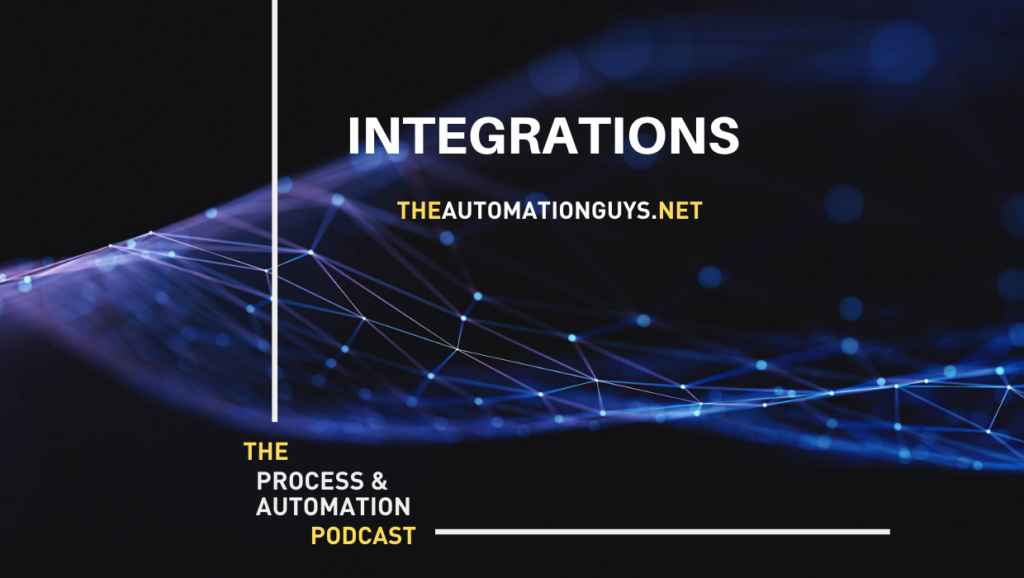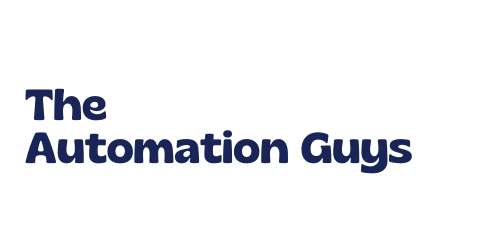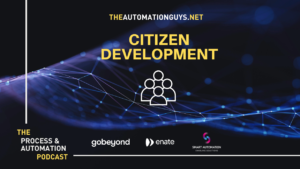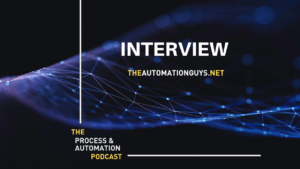Blog

How to overcome the challenges that face integrations
In this episode of the Process and Automation Podcast we are focusing on Integration and iPaaS as part of a wider automation initiative.
Share This Post
Do you have any questions? Would you like to give us feedback? Are you interested in workshops on the topic of automation? Are you an expert in the field of automation and would like to be on the podcast?
LinkedIn Arno: https://bit.ly/3aABArd
LinkedIn Sascha: https://bit.ly/36Jd31T
Velocity-IT: https://www.velocity-it.com/about-us/
convedo Group: https://www.convedo.com/about-us
Episode Transcript
Hello and welcome back to another episode of the process and automation podcast with the automation guys. In today’s episode, we will focus on integration. If you’re following a bit, what is going on with intelligent automation, you might have heard that integration is one of the very important pillars of intelligent automation.
So, and, uh, in as organizations become more digital. Applications will intact, not just with other software, but also was people, was our devices with chat bot. And we have to work with even larger volume of data. That’s why we see intelligent integration is very important. And, so in this episode, let’s see how companies can enhance the value and usefulness of their data assets.
Arno what do we have in stock for, for the listeners today? So I think there is a sort of tendency to overlook integration, specifically, disparate data sources, various data sources within site, the hyper automation space. And what we really want to look at today is how do you create a sort of a trusted data source that all of your automation can.
Integrate with now, you know, of course, if you look at organizations out there, um, Uh, each of those organizations, wouldn’t just have one system, uh, for, uh, all of the operations and management purposes. You know, the challenge today is as we have got these multi, uh, systems and all of the systems out there for, uh, let’s say operations, like I’ve mentioned, um, need to be able to, uh, talk to each other.
And of course, then you have on-premises software. As well, um, you know, you throw, uh, sort of, uh, web-based cloud-based systems in their mobile applications as well. So, multiply all of these sort of systems together and these integration points, um, Traditional integration technologies really struggle to handle, um, you know, this type of influx, um, of off software and the actual requirement to integrate these software packages together, and, you know, managing this integration is, is becoming very, very complicated.
And of course, as you add more applications into the mix. Um, the more, the more complex this integration process becomes and, and really what, what we need in, in, in, uh, you know, to solve this problem. Or tools to, to make, uh, integration simpler. You know, we want to have a continuous flow of data between the different applications and, you know, provide a very cost effective in a scalable and an also a real reliable way to, to acquire the right information and present it to, to the people.
At the time that they need it. And so, so, so, so if you look out there in, in terms of integration possibilities, they are now, uh, a new breed of integration solutions, um, that has arisen that, that offers, uh, you know, a solution to these. Problems and you know, it is the so-called, um, integration as a service or integration platform as a service or I-PASS.
Um, so these, these technologies really help you to, um, take all of these data sources from, from all of these different. Uh, platforms and services and really bring it together in, in one centralized place. Um, and of course that’s the place that you can plug in your automation, like your RPA soft, soft software bots, your chatbots, your workflow systems, your low-code automation system, and so on and so forth.
Yeah, I think that’s a, it, it’s a very, very important part of when we think about end to end automation. Uh, anyway, so I think, um, if we really want to get this under control, um, yeah, and I think we can’t can’t get, get around this, um, uh, I-PASS um, infrastructure, um, or IPS. Thing, um, what it is these days. So what is called, um, I think, um, system to system integration and, um, all these API APIs, these days, hundreds of APIs, all this data, it is increasing massively.
And, um, so yeah, there were, there was one, uh, analyst firm. So they, that they. They said, yeah. Okay. Everything is increasing around these areas, API APIs, a system to system integration on that 50% per year. So you can imagine now that this is a, yeah, this is not really manageable. And, um, uh, and it’s time to really tackle that problem of, uh, of that integration.
Yeah, and it needs to be addressed because, um, of course, you know, more and more data volumes are, uh, are created every year. And, um, you know, if, if you don’t solve this problem, um, you know, your business data will become inaccessible because there it’s just too many data points and too many application silos.
And, you know, if we look at the. The legacy integrations or strategies. Um, you know, we, we, we, we, we still have outdated solutions for that. And so for example, we’ve got custom integrations where people still have custom built integrations. So these are all hard coded sort of API APIs that requires very in-depth technical skill to understand how it works, their technology, they are built on.
The support around these are quite cumbersome, you know, the data formats and the structures of these can be quite complicated as well. So it says very hard to, to actually maintain these, um, this integration code around. Uh, custom integration then of course, you know, um, there’s another, uh, strategy, um, which came about sort of in the nineties, which is an enterprise service bus.
Um, and this, you know, was designed for batch orientated, sort of data processing. Um, so service bus, um, you know, it, it can handle both, um, real time and your, uh, sort of. Uh, event driven integration needs. Um, but it, you know, it hasn’t really been built for the cloud. It’s kind of more sort of formal on premise, um, application, uh, you know, uh, if you look at things like BISTalk, for example, BISTalk was, was an enterprise service bus.
Um, so that that’s a good example of, of, of a tool that Microsoft created. And of course, you know, the third strategy was traditional data exchange where. You know, we extract data from one application and then we import it into, uh, another application, maybe using a, not nightly data transfer. Um, you know, these so-called ETL.
Uh, extract transform and load scripts. And you know, where we, we literally suck data from one place, put it in a centralized database, um, maybe transform the data slightly. Um, and these are all kind of custom perhaps SQL script that, um, so it’s, it’s, it’s very, very old school. Um, it’s not very agile. And, um, you know, it’s, it’s, it’s very out outdated ways of, of, of handling, um, you know, integration and data integration and, and, and getting those datas from those silos silos, the centralized process or a place, but really a modern integration approach.
Is it’s really needed to tackle this problem. Absolutely. And I think, um, what you just mentioned, um, I think that was a big reason why, or is a big reason still why RPA is such a successful, uh, success story. Um, because, um, so, so was these kinds of rigid things in place sometimes it’s so complex, you don’t even want to touch it because, uh, yeah.
It’s you can’t maintain it. And sometimes. The integrations and new integrations you rather do very quickly was RPA. Instead of going through the proper, um, integration methods you would think of, uh, using today, um, sort of modern approach. Um, I think, uh, Yeah. So RPA has sort of filled the gap there. Yeah.
So about the modern approach is definitely needed. Um, um, so all these modern applications, they already, we have interfaces. So, um, yeah, let’s, let’s work with this one. So. Um, yeah, for the, for the modern business, uh, it is clear that we need more, we need more streamline technologies, um, to, to integrate the systems of the future.
So it has to work on premise. It has to work in cloud. It has to work was mobile applications. It has to be really, really easy to use and lightweight. I think that’s, that’s, that’s what everyone wants these days. And, um, uh, We develop very agile, uh, our software, um, programs and companies are very agile. So, so this kind of integration methods, they need to flow with this agile approaches.
We, we, we, we have every day. So, um, allowing for, for these rapid iterations and, um, yeah, they shouldn’t be too complex. So if someone is leaving a team, someone should be able to really pick that stuff up. Some, some of these stories, what you mentioned earlier, there was one custom, uh, custom integrations.
One-on-one, uh, some people have really nightmares because of that kind of stuff. What’s happening in that. So what happens if we need to change something? What happens if the system, the underlying system where this integration is running on a it’s out of support? So I think, um, yeah, this is where we really need these, um, uh, very, um, yeah, not too complex systems going in.
And, uh, yeah. Uh, I think this is where integration platform as a service comes into the picture. And, um, as, as we mentioned already before, um, yeah, I pass is used for building and deploying these integrated applications in the cloud and within the enterprise. So probably more and more companies are really, really, uh, going towards the cloud.
So I think that’s, um, Yeah. It’s time to really replace a, this middleware cannot connecting these, uh, these in-house applications was, uh, w was this kind of modern application. So, I don’t know. What do you, what do you think, how can we address this new integration challenges was high-pass specifically?
Yeah. So of course I-PASS is a concept that has been built with cloud in mind. Um, So it’s cloud native and, um, you know, it, it has got flexibility and scalability built with inside it because obviously it’s cloud hosted. So, so it can address these integration challenges, um, that, that you’ve. That we’ve spoken about, um, you know, more easily.
So, you know, so, so, so, so there are a couple of challenges that, that, that we look at the desk put solve. Um, you know, so, so for instance, um, hybrid integration where you have, um, you know, still on premises systems and you’ve got cloud applications, That need to interact. Um, so, uh, you know, our I-PASS, um, can, can address these issues by providing that seamless integration between your, um, hybrid system.
So your, your on-prem and your, your cloud-based systems, um, you know, you can maintain security, for example, um, you know, it could also ensure that there’s data in check Tegrity. You know, between these, the, the systems, um, you know, uh, and again, security data security is quite an important topic. Um, so, so, so I, uh, uh, you know, uh, our I-PASS solution, a best of breed, iPad solution, you know, can.
Can ensure that that security element of this is, is, is maintained. Um, and for instance, if you have, um, uh, API APIs with inside your, your business, um, where you need, uh, access, well, that provides your sort of real-time access to, to, to, to your data. Um, you know, if you have got sort of a, um, a lot of these API APIs and, and, and, and, you know, it keeps on growing.
So. So-called sort of integration, proliferation, um, using, uh, I-PASS, uh, approach is, is quite sensible because you could then, um, sort of manage those API APIs better and you can integrate those API together and hide some of the complexities. Of those implementations and just provide a very sort of, uh, sort of, uh, a single point, um, you know, for your data that, that these other applications, um, you know, can, can connect to.
And, you know, of course, if you do have, again, a lot of, sort of. Uh, legacy type, um, you know, uh, integration points and, um, you know, you want to, uh, not necessarily retire that, um, maybe perhaps, you know, some of these things are, or has been in your business for, for a very long time. Um, you know, there might be at a certain degree of technical debt, um, uh, attached to these, if you don’t necessarily want to upgrade to replace them, um, you know, with, with iPads, you could, you could really sort of.
Still support those existing legacy, um, API APIs, but, um, you know, great and a nice facade in front of them to, to ensure that all of, all of that is abstracted away. Um, and you know, you, you, you have one. A centralized place that you can manage those, those, those, those legacy IP APIs. Um, so I think, you know, I pass or something, like I said, it, it is something that can sometimes be a bit overlooked, but it does make sense.
Um, especially when you look at, uh, you know, the amount of systems that we connect, the amount of data we, we generate. So it’s definitely something that. Um, needs to be thought about, you know, when you look at your overall it architecture, you know, as a, as a CIO, for example, Absolutely. That’s a, that’s a big, big point.
Yeah. Uh, technical debt. We see that as well. Um, yeah. In, in other areas as well, not just in the, um, uh, in this, um, integration elements are so the whole intelligent automation, uh, when it comes to work flows and own developed applications, somewhere in companies, I think technical debt is, uh, yeah, it’s a big one.
Um, uh, and it needs to be addressed. So yeah, more and more of, uh, Systems architecture. Um, Yeah, it’s, it’s growing, uh, on premise or in the cloud. And, uh, it really needs, um, uh, needs this, um, this new I-PASS, uh, infrastructure in place to really. Yeah, manage it much better managed, quite complex. It systems and architecture.
And, um, I think was I-PASS you will really get this greater flexibility. Um, lots of benefits. Um, we had talked thinking about our lowering costs and this is clearly one, uh, which will over time, uh, lower your general costs, total cost of ownership and, uh, I think this is a good foundation. You, you can put in place for, for better scalability going forward.
And, um, yeah, it was out that, um, you know, you will go through all these challenges. Uh, Arnold just mentioned and, um, yeah, absolutely. There’s something you should look at and, um, yeah. And. And does, this is a, I think really a key for every organization who really wants to push forward on this digital agenda and, um, to get the most out of everything for the end to end integration, uh, not enter into automation really, uh, off of all the business processes.
Yeah. And I guess, you know, what you want to have is a really sort of a centralized place where, um, you know, you have got stock of all of your various API APIs and integrations that is managed in one place. Um, it’s scalable. Um, and of course, you know, you could easily create your integration flows.
Between these various data sources have that really managed, um, and, and also have that scalable and also very stable. So, and, you know, also you want to be in a place where, um, you know, that that data sources trusted. So if you overlay automations on top of that, You know, for a fact that your, um, your D your data integration service that you provide, you know, for the various automation services.
So it could be RPA bots, chatbots, you know, workflow automation that is stable, it’s properly managed. It’s very scalable, and you can also extend it. Um, and it also provides you the, the, um, you know, the opportunity to then. Retire some of your older legacy API APIs that because you, you you’ve created this abstraction now where you you’ve got a middle layer between your consumers and also the providers of data.
Um, and once that extraction is placed, you could easily slop a provider out, uh, retire it, um, and then plug in. The replacement without disrupting any of the consumers and the way that they consume the data. Yeah. And it, I think it is, uh, uh, I think is something really great because nowadays all sorts of enterprise business applications are using, um, uh, available via apps and, um, um, But instead of doing this one-on-one integration again.
Sure. You can connect to application a was application B directly was API APIs and that very easily, but it doesn’t really make sense to, to build that kind of one-on-one integrations again. So yeah, it was more and more of these enterprise applications coming in. Um, you can probably pluck. 30 40 different applications.
You’re currently using, uh, SAP, Salesforce, Oracle, Workday, all this, all these really big enterprise systems. Um, you can pluck them easily on these, uh, I-PASS platform. Um, and, um, yeah, instead of going direct and have, have to have the full control, how. Because sometimes it is as well, a flow of these integrations together.
Um, um, so, so yeah, you’ll have, uh, yeah, lots of really good opportunities, um, implementing that. Yeah. And like you say, you want to avoid data silos. That’s not just possible. Um, you know, I think unfortunately with the choices out there with SAS systems, the minute there’s just so many different types of SAS capabilities that you can get, you know, HR systems, CRM systems, sales management, opportunity management, you know, loads of these, these types of systems.
And. You know, although they do have got really, really good modern API integration capabilities, um, you want to be in a place where as, as you get more of those systems or use more of those systems, plus you have to consider your legacy systems you’ve got on premise. For example, I think the need, especially when you start looking at.
Automation between enterprise automation between these different systems, the need for this sort of data layer is becoming really, really important. Um, so that, you know, you, you have got these, um, closely coupled systems that, um, you know, integrate with this, this, this data layer you can plug in your automations into that.
And it also reduces, um, data duplication, for instance, So, so it’s, it’s something that, that, uh, that I said earlier in, um, you know, in, in this discussion and that can sometimes be overlooked because there’s a lot of hype around automation and how people want to jump in and start doing the automation. But I think sometimes you have to look at your, your integration as well, your, um, your data layer, you know, and make sure that you’re not creating more silos.
You’re, you’re providing a nice, trusted, um, centralized. You know, uh, 0.4 for your business data. Absolutely. Yeah. Great. Um, yeah. Thank you very much for listening again today to our episode. Um, lots of really good things, um, to, to try out, I guess, um, to look into it and maybe start implementing, they all sorts of, uh, easy ways to get started, um, as your intake role mods, all sorts of I-PASS platforms out there and, um, uh, yeah, and you just get started and maybe see you see very quick benefits.
Um, so. We’ll cover a very likely, a couple of use cases for I-PASS, uh, over the next, um, episodes. So yeah. Make sure you subscribe to our podcast. There’s you’re not missing any, uh, any of those kind of episodes and yeah, again, thank you very much for listening. That’s it. Again, was this episode of the process and automation podcast.
If you liked this episode, please give us a five-star rating and don’t forget to subscribe to this podcast. So you don’t miss any upcoming episode. We hope you’ll tune in next time. And until then let’s automate it.
- May 4, 2021
- 8:40 pm


